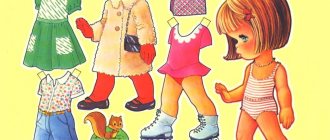Didactic game in environmental education of preschool children
The ecological state of our planet and the trend towards its deterioration now requires living people to understand the current situation and have a conscious attitude towards it.
Recently, water bodies have become increasingly polluted and lifeless, soil fertility is losing, flora and fauna are becoming depleted, acid rain is falling - this is an alarming signal calling for a reasonable attitude towards the world around us.
Environmental protection and a reasonable attitude towards it have become a real pressing problem of the century.
Instilling in preschool children responsibility for the fate of the nature of their native land, involving children in all possible assistance in its protection is one of the most pressing tasks of today.
Work on the formation of an ecological culture should begin from preschool age, when the basic ways of understanding the surrounding reality are laid down and a value-based attitude towards it develops. It is necessary to make the most of this period of time, to educate children to understand the correct attitude towards nature.
Nature has a huge influence on the formation of personality, its mental, moral, labor and physical development, and helps improve logical thinking and speech.
Environmental education of preschool children is a continuous process of training, education and development of the child, aimed at the formation of his ecological culture, which is manifested in an emotionally positive attitude towards nature, the environment, a responsible attitude towards one’s health and the state of the environment, and compliance with certain standards in system of value orientations. [6, p.15]
The methodology for forming elements of environmental culture in preschoolers should take into account the psychological characteristics of children of this age. The leading activity of preschool children is PLAY. In the traditional method of introducing children to nature, play as a method of environmental education is poorly represented. In recent years, a number of recommendations have been developed for the use of game methods in environmental education.
In this regard, we have identified a need for a deeper and more comprehensive study of the game method when introducing children to nature. This is connected with the search for the most rational and effective ways of educating preschool children, with the introduction of gaming techniques into the practice of teaching and educating younger schoolchildren, and the use of new types of gaming activities.
The purpose of this work is to study the game as a method and determine its role in the environmental education of preschool children.
In accordance with this goal, the following tasks have been set:
- Determining the place of play in the environmental education of preschool children.
- Identification of the structure of didactic games.
- Classification of didactic games depending on the tasks being solved.
- Using a variety of environmental games developed by specialists S. N. Nikolaeva, M. A. Ryzhova, G. N. Kazaruchik.
- Development and use of didactic games with environmental content for children of different age groups.
In the life of preschool children, play is a leading activity. “It enriches and develops the personality, therefore it should be as widely used in environmental education as in other areas of education: play brings joy to the child, therefore knowledge of nature, communication with it, taking place against its background, will be especially effective; the game creates optimal conditions for education and learning.”
“Play is an emotional activity: a child playing is in a good mood, active and friendly. The effectiveness of familiarization with nature largely depends on the child’s emotional attitude towards the teacher who teaches, gives tasks, organizes observations and practical interaction with plants and animals. Therefore, the first point, which combines two aspects of pedagogy (play and familiarization with nature), is to “immerse children in their favorite activities and create a favorable emotional background for the perception of “natural” content.”
The second significant point is related to the development of children’s attitude towards nature, which, within the framework of environmental education, is the end result. Psychologists consider play activity as a manifestation in a child of a positive attitude towards the content that it carries. Everything that children like, everything that impresses them, is transformed into the practice of a plot or some other game. Therefore, if preschoolers organized a game based on a natural history plot (zoo, farm, circus, etc.), this means that the resulting ideas turned out to be vivid, memorable, evoked an emotional response, and were transformed into an attitude that provoked it.
In turn, the assimilation of knowledge about nature through games that evoke emotions cannot but influence the formation of a careful and attentive attitude towards objects of the flora and fauna. And environmental knowledge that evokes an emotional reaction in children will enter into their independent play and become its content, better than knowledge whose impact affects only the intellectual sphere.
The structure and classification of didactic games is known [1, p. 276].
Among the variety of games for preschoolers, a special place belongs to didactic games. Didactic games are a type of games with rules, specially created by pedagogy for the purpose of raising and teaching children. These games are aimed at solving specific learning problems, but, at the same time, they demonstrate the educational and developmental influence of gaming activities.
Didactic material allows you to make the educational material exciting and create a joyful mood.
A didactic game has a certain structure that characterizes the game as a form of learning and gaming activity at the same time. The following components of the game are distinguished:
– didactic task;
– game task;
– game actions;
- rules of the game;
– result (summarizing).
Didactic games are varied in their content, game material, game actions, and cognitive activity.
Let's take a closer look at didactic games with environmental content.
Didactic games of ecological content help the child to see the uniqueness of not only a certain living organism, but also the ecosystem, to realize the impossibility of violating its integrity, to understand that unreasonable intervention in nature can lead to significant changes both within the ecosystem itself and beyond its borders.
In the process of communicating with nature in a playful way, children develop emotional responsiveness, develop the ability and desire to actively preserve and protect nature, to see living objects in all the diversity of their properties and qualities, features and manifestations; participate in creating the necessary conditions for the normal functioning of living beings within the reach of children; understand the importance of nature conservation, consciously follow the norms of behavior in nature.
Didactic games of environmental content are varied depending on the tasks solved when using them.
Didactic games with environmental content
a) didactic games to enrich environmental ideas
When developing and conducting such games, you must adhere to the following provisions:
– older preschoolers feel an increased need for play activities (especially at the beginning of education), which satisfies their interest and activity in mastering the world around them;
– a didactic game arouses pleasant feelings and emotions in children, which reduce tension in the educational process. As a result, the efforts of pupils are directed towards cognitive activity;
– in the didactic game, preschoolers exhibit creative activity, different components of the psyche: sensation, perception, memory, etc., which means that all cognitive processes are activated.
The use of didactic games to expand and deepen environmental ideas should take into account those ideas that can be formed in children of senior preschool age:
– about the diversity and diversity of natural objects, about plants and animals as living organisms;
– about relationships and interdependencies in nature (between inanimate and living nature, between objects of living nature);
– about man as a part of nature;
– about the culture of behavior in nature.
It is advisable to carry out didactic games in this series with a small subgroup of children and use them variably depending on the level of development of preschoolers’ ecological ideas.
The introduction of an element of competition, both individual and team, as well as problem situations, also contributes to increasing interest in the didactic game and natural objects that are played out.
b) didactic games for developing an emotional and value-based attitude towards nature
The mere presence of environmental ideas does not guarantee environmentally appropriate behavior of an individual. This also requires an appropriate relationship with nature. It determines the nature of the goals of interaction with nature, its motives, and the readiness to act from the point of view of environmental feasibility.
A series of didactic games for developing an emotional and value-based attitude towards nature includes two blocks:
a) games for the development of aesthetic perception of nature (a sense of beauty in nature, an emotional attitude towards it);
b) games for the formation of moral and evaluative experience of the behavior of preschool children in nature.
The essence of didactic games for the development of aesthetic perception of nature is that preschoolers, when in direct contact with natural objects (observation or closer contact; touching a plant, animal, stroking a trunk, leaves, etc.) should tell something interesting about object of nature. These may be features of appearance, features of growth, development, care, or cases of caring (cruel) attitude of people towards plants and animals.
It must be emphasized that in games aimed at developing the aesthetic perception of nature, previously accumulated knowledge and mental actions especially enrich and expand the sphere of feelings and experiences, giving them meaning. With such mental activity associated with nature, an emotional impulse is born, indifference and indifference are completely eliminated - mental tension, creative thinking, and a passionate desire to learn more that are new, super interesting and unusual for oneself increase; secondly, a certain attitude towards nature as a whole and towards its specific object is created, attention to them is sharpened and, consequently, a process of emotional and psychological readiness to accept interesting and useful information about nature occurs, that is, a versatile interest in knowledge is manifested. The child becomes attentive to the natural world and everything that happens in it, takes the position of a protector and creator of beauty in nature. As a result, emotional responsiveness is formed, the joy of upcoming knowledge, the excitement of meeting the unknown in nature, anticipation of unusual and wonderful encounters in this world, one’s strengths and abilities regarding the study of the surrounding nature.
The basis of didactic games for the formation of moral and evaluative experience of behavior in nature are certain situations. During the games, the consequences of good and bad human actions in nature are discussed, they search for their own solutions in difficult situations, and children learn to motivate their decisions.
The peculiarity of the didactic games of this block is that they do not give children a ready-made recipe for behavior, but gradually lead them to their own conclusions and conclusions, which is more valuable than simply offering prohibitions and instructions in accordance with which children must act.
c) didactic games for introduction to environmentally oriented activities.
An important indicator of the environmental education of preschoolers is their participation in activities that are environmentally oriented, during which environmental ideas are deepened and consolidated and an active humane attitude towards nature is manifested. At the same time, it is necessary to take into account the fact that wild nature gets along well without human activity; it lives according to its own laws. You should take care of natural objects only in an environment modified by people: in a city, a park, and in a preschool institution - on a plot, in a living corner. Therefore, it is necessary to help plants and animals living next to people: trees in parks, plots, plants in flower beds, city birds starving in winter, that is, those whose well-being depends on the actions of people. Therefore, the content of environmental activities for children of senior preschool age includes: systematic care of plants and animals of a corner of nature, an ecological room; organization of duty; work on the kindergarten site (in the garden, vegetable garden, flowerbed); feeding birds in winter; organization of labor landings and raids. The purpose of this activity is to daily maintain the conditions necessary for the full life of all living beings.
Labor activities of environmental content should be organized systematically, with gradual complication. Each child must demonstrate their strengths and abilities, gain experience and put it into practice. Such activities teach us to think and really care about the “little brothers” who share the same living space with children. It is advisable to combine the work of preschoolers with environmental games, observations, conversations, etc.
A series of didactic games for introducing older preschoolers to feasible environmentally oriented activities differs from games in previous series by being more entertaining, dynamic (some didactic games contain elements of outdoor games) and less stressful mental activity. The main goal of these games is to create motivation in preschoolers for environmental activities; arouse their interest and desire to care for natural objects, emotionally attune children to one or another type of work, and activate them in the process of carrying out assignments.
It is also advisable to conduct didactic games in this series in subgroups depending on the level of environmental education, the degree to which children have mastered labor skills and the ability to care for living objects. In this regard, game tasks should be selected. The introduction of gaming techniques into the practice of teaching and upbringing preschoolers can be carried out as follows:
With children of primary preschool age, when observing autumn trees, we examine the leaves of birch and maple, highlight and name the characteristic features of their shape and color. Then we play the game “Find the tree” (“One, two, three, run under the maple”)
With older children, who have received their first knowledge about the forest, you can dance around the birch tree, saying and chanting folk words, depicting with your hands how it sways (“The birch tree is green, cheerful in the spring, stands in the middle of the field, rustling with its leaves”).
Didactic games also play an important role in consolidating knowledge about nature. The teacher needs to explain the rules of the game, compliance with which makes the game interesting and does not reduce it to an exercise. With older preschoolers, board and printed games are used (“Zoological Lotto”, “Which Branch Are Children From”, etc.)
Verbal and didactic games can be varied. They can brighten up leisure time, a walk in the rain, forced waiting and do not require special conditions or equipment. They are best carried out with older preschoolers who already have a fairly wide range of ideas about nature, and in whom an image of an object appears behind a word. These games intensively develop thinking, flexibility and dynamism of ideas. The ability to use existing knowledge, compare and combine objects according to a variety of criteria: attention, speed, reaction. For example: “Complete the sentence.” The teacher says the beginning of the phrase, and the children must come up with the end. “The squirrel stores food in the fall………”, “In the spring the buds on the trees swell and bloom because………” or “The lemon is yellow, and the cucumber……”, “Chamomile is white, and cornflower…”, etc.
Among the games of environmental content, object games are used in practice, which involve the use of games of natural objects: cones, pebbles, shells, etc. Natural material allows you to organize a number of games that contribute to the development of the child’s thinking. For example, objects can be classified according to different criteria: color, size, nature of origin, shape. During excursions and walks, the game “Guess what’s in the bag?” is used. Various natural objects are placed in a small bag. The child’s task is to identify the object by touch. This is one of the game options aimed at the sensory development of a child.
Using didactic games of environmental content in their work, teachers expand and enrich children’s knowledge about their native nature. Thanks to this, children’s cognitive interests are formed and clearly manifested, and questions arise: why? Why? Where? Mental activity becomes more active, and children’s answers become more detailed.
Didactic games of environmental content help in solving problems in the formation of the foundations of the ecological culture of preschoolers.
Summarizing the above material, it should be noted that play is the leading activity of preschool children; it enriches and develops personality.
The effectiveness of didactic games with environmental content depends entirely on the creation of conditions and their correct use. A necessary condition for the successful implementation of a didactic game of environmental content is the availability of gaming material: sets of toys, dolls depicting characters from famous fairy tales, a variety of handouts, sets of board and printed games.
It is advisable to carry out didactic games of environmental content with a small subgroup of children, to use them variably depending on the level of development of environmental ideas and the age characteristics of preschoolers.
The effectiveness of the game depends on the actions and preparation of the teacher. He thinks through, organizes the game, prepares the necessary paraphernalia, saturates the game with actions and dialogues, through which the didactic goal is achieved.
Thus, the game as a method of environmental education helps in solving problems in the formation of the foundations of environmental culture.
Literature:
- S. A. Kozlova, T. A. Kulikova “Preschool pedagogy” M.: “Academy”, 1998
- S. N. Nikolaeva. Methods of environmental education of preschool children. M.: "Academy", 1999.
- S. N. Nikolaeva “Young ecologist”. The program and conditions for its implementation in kindergarten.
- Kondratyeva N. N. Children's environmental education program “We”, St. Petersburg 1996.
- Cherezova L. B. “Theory and methodology of environmental education of children”, Volgograd, publishing house VSPU “Peremena” 2010.
- Ryzhova N. A. “Environmental education in kindergarten”, Moscow 2001.
MAGAZINE Preschooler.RF
Experience on the topic: “The role of didactic games in environmental education of preschool children”Educator: 1st qualification category Gizdatullina T.V. Almetyevsk, 2022 Municipal budgetary preschool educational institution “TsRR No. 65 “Ivushka” Almetyevsk
Ecology is not only a science. This is the worldview of a modern person, aware of his responsibility for the future for all of us, at home - planet Earth, so beautiful, so big and so fragile. Currently, the main goal of a person’s ecological culture, which determines his spiritual life and actions, involves mastering a body of knowledge and skills in ecology, respect, and a humanistic attitude towards all living things and the environment.
The formation of an ecological culture, the foundation of which is knowledge about nature and practical skills to protect it, is one of the most pressing problems of preschool education, since instilling a love for nature and cultivating a caring attitude towards it must begin at this age. Environmental education is a pressing problem of our time. The worsening lack of environmental culture dictates the need for intensive educational work to develop an ecological culture of environmental management among the population. A reasonable attitude towards nature and the surrounding world should become one of the criteria for assessing the morality of humanity. Environmental education is, first of all, the education of humanity, that is, kindness, a responsible attitude towards nature, towards the people who live nearby. This work begins in kindergarten.
Our nature is fabulously rich. And how children will treat her largely depends on the adults involved in their upbringing. When solving the problems of environmental education in preschool age, it is first of all necessary to form a system of knowledge about nature, teach children to understand and establish existing connections and dependencies, and act in accordance with the acquired knowledge.
It is during this period that a positive attitude towards nature, the man-made world, towards oneself and the people around them is formed.
The goal of the work on environmental education: the development of children's scientific - cognitive, emotional - moral, practical - active
attitude towards the environment and one's health.
To achieve this goal, it is necessary to solve the following tasks:
- formation of initial skills and habits of environmentally literate behavior that is safe for nature and for the children themselves
- fostering a humane, careful, caring attitude towards the natural world and the surrounding world as a whole
- formation of empathy skills (the ability to foresee the consequences of some of one’s actions in relation to the environment)
- help children learn to understand nature and establish the connections that exist in it.
To familiarize children with nature and environmental education, it is necessary to use various forms of work with children. But, since play is the most joyful and natural type of activity, I decided to use didactic games in my work. This is an independent activity that contributes to the development of the individual, and a means of uniting the children’s community, and a method of organizing other types of activities, and a way of communication. Games have a significant impact on the intellectual development of children: children learn to generalize objects, compare them, and perform mental operations. Didactic games evoke a positive attitude towards the work done, arouse interest in children, stimulate activity, and a desire to play. Didactic games are an effective means of mental, aesthetic and moral education of preschool children. With the help of didactic games, children effortlessly acquire a complex of environmental knowledge. These games allow you to present knowledge in an accessible, fun way. Games add emotional coloring to educational activities and make them more interesting for children. Didactic games allow children to develop a wide variety of positive qualities. The group has a lot of nature games. I made some games myself, and also selected well-known ones that contain environmentally correct or developmental gaming activities in accordance with the assigned tasks. I think that it is very important to use such didactic games that will be useful and interesting for children, that children will want to play and will be able to use their knowledge when communicating with natural objects.
She introduced the children to the seasons in several stages: together with the children we looked at illustrations, observed nature on walks; I read stories about the seasons: N. Sladkov “The Multi-Colored Land” , G. Skrebitsky “Four Artists” , I. Sokolov - Mikitov “A Year in the Forest” , “Anthology for Children” , encyclopedia.
After the children had accumulated a sufficient amount of knowledge, I consolidated the children’s knowledge about the seasons in games. For this I used didactic games: “What time of year?” , “Name it in order” , “When does this happen?” , “What’s extra?” . Children named the seasons in order and noted the characteristic features of each season. In the games “Seasons” , “Outfits of Mother Earth” , children consolidated and refined their knowledge about each season. I drew the children’s attention to the fact that writers and poets sing of the beauty of nature at different times of the year. At the same time, she read poems, asked riddles, and the children, using their existing knowledge, determined the season. I tried to arouse children’s interest in natural phenomena, taught them to perceive poetic text and the ability to clearly express their thoughts.
We looked at the trees and told the children about the characteristics of each tree: “What is the difference between birch and another tree?” (white trunk, catkins in spring, thin branches growing downwards). Pine differs from spruce in that pine has long needles, while spruce has short needles. And their cones are different: small for pine, large for spruce. Bees collect nectar from linden flowers, which is why linden is called a sweet tree. Oak is a strong, mighty tree. Its fruits are called acorns. Bullfinches feed on rowan fruits. I told the children what benefits trees bring. During educational activities, at different times of the year, she taught me to notice the changes that occur in nature, to admire nature at different times of the year. We played the following games: “Name the tree” , “Find the same one” , “Whose leaf?” , “Find a pair” , “Which branch are the kids from?” . “Forest City” with the children . By playing this game, children learn that the forest is a whole city consisting of special houses. A tree, a bush, a blade of grass is a shelter, a home, a home for living creatures living in a given environment. Children will learn that a variety of creatures live in the forest, not just anywhere, but in strictly defined places. Each of them has a unique apartment.
There are also “floors” . I asked the children questions:
- Why are frogs called amphibians?
- How does a hedgehog behave in a moment of danger?
- What materials are used to build a nest?
- On what tiers can birds be found? (almost all).
- How many pairs of legs do insects have?
- Who is the bark beetle?
During the game, moving along a certain route, children become acquainted not only with the inhabitants of their tier, but also with other inhabitants of the forest. She told the children that flowers, berries, and mushrooms grow in the forest. By playing the game “For mushrooms, for berries,” we consolidated children’s knowledge about berries and mushrooms. Played the game “Where does it grow?” , introduced me to plants: field, garden, meadow. The names of the plants were fixed.
The group has a corner of nature; this is one of the conditions for visually and effectively introducing children to nature. Houseplants are valuable teaching material. Introduced children to indoor plants. Each plant was examined. They noted the structure and named the parts of plants. I played games with the children: “Name the plant” , “Guess what’s missing?” , "Guess by Scripture" . Children independently described the plant and played the game “Make a Plant” using models of plant parts. By introducing the objects of nature, I tried to instill in children a caring attitude towards nature.
She also introduced children to medicinal plants. To do this, I chose those plants that can relieve colds and coughs. They noted which parts of plants are useful. The children talked about medicinal plants from their own experience.
Introduced children to the animal world: domestic animals, wild animals, animals of hot countries, animals of the North; with the peculiarities of the appearance of animals, the behavior of adult animals and their young. She told the children how they live, what they eat, how they escape from enemies, what benefits they bring, how the lives of animals change with the change of seasons. I used the games: “Name the animal” , “Name the babies” , “Whose house is it” . I read poems to the children, asked riddles about animals, insects, and birds. She also introduced me to the animal world of my native land. The children reflected the acquired knowledge about nature in drawings, modeling, and appliqué.
To generalize and consolidate knowledge about living objects of nature, I played didactic games with the children: “What’s extra?” , “Who’s the odd one out?” . The children looked at the cards and identified an extra object from the group, giving reasons for their statements. For example: hare, bear, hedgehog. Children determine that the hare is superfluous, because the bear and the hedgehog sleep in winter, but the hare does not. On the card there is an ant, a dragonfly and a butterfly. We need to find who is the odd one out. Children call the ant odd. And they conclude: the ant is superfluous because it crawls. And the butterfly and dragonfly fly.
We talked a lot about the rules of behavior in nature: “Ecological traffic light” , “Food chains” . “We are friends of nature” , “What will happen if...” . These games helped me introduce children to the rules of behavior in nature, as well as notice the consequences of human actions in relation to nature. Children learned to draw conclusions: if something disappears in nature, it will lead to disaster, that everything in nature is necessary. Children received a sufficient amount of knowledge, learned the rules of behavior in nature: do not break bushes and trees, do not destroy bird nests, take care of birds in the cold season, do not leave garbage in recreation areas, do not make noise in the forest, do not pick flowers, do not catch insects , do not pollute rivers, lakes, protect nature.
The result of the work was a lesson for kindergarten teachers and parents: Introducing children to nature using didactic games on the topic: . ” The children showed that they have a sufficient supply of knowledge about plants, animals, and the nature around us; they know the rules of behavior in nature, how to protect it and take care of it.
I believe that didactic games helped to develop in children a friendly, sensitive attitude towards nature. I hope that all the work done has given the children a mindset for correct behavior in nature, among their peers and among adults.
| Next > |







